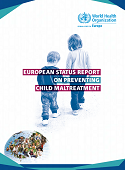European status report on preventing child maltreatment (2018)

Download
2018, x + 113 pages
ISBN 978 92 890 5354 9
This publication is only available online.
Child maltreatment is a major public health problem, affecting at least 55 million children in the WHO European Region. The impact of abuse and/or neglect in childhood is detrimental to physical, psychological and reproductive health throughout the life-course, yet the high costs to society are avoidable. There are clear risk factors for maltreatment at the level of the individual, family, community and society. This status report documents the progress that has been made by Member States in implementing the WHO European child maltreatment prevention action plan 2015–2020 at its midpoint. The plan has a target of a 20% reduction in child maltreatment and homicides by 2020.
Data were collected through a survey of government-appointed national data coordinators of 49 participating countries in the Region. Results show that good progress is being made overall towards achieving the objectives. Development of national policy for the prevention of child maltreatment has increased across the Region, with three quarters of countries reporting an action plan, but these must be informed by robust national data. Surveillance of child maltreatment remains inadequate in many countries, with information systems in low- and middle-income countries most in need of strengthening. Legislation to prevent maltreatment is widespread, but better enforcement is warranted. The implementation of child maltreatment prevention programmes, including home-visiting, parenting education, school and hospital-based initiatives, has accelerated, but evaluation of impact is needed. Child maltreatment is a societal issue that crosses sectoral boundaries, meaning a sustained, systematic, multidisciplinary and evidence-informed approach to prevention must remain a priority for governments.



